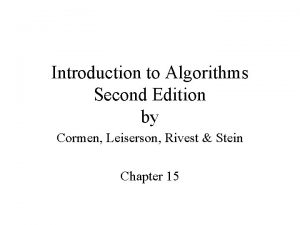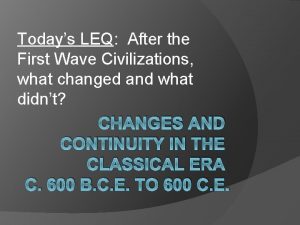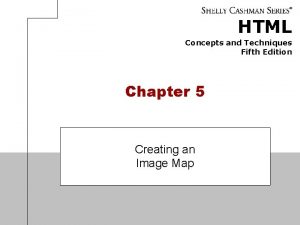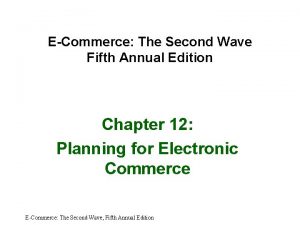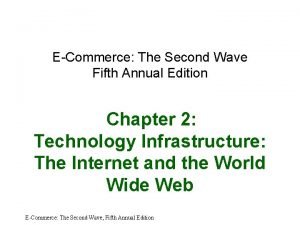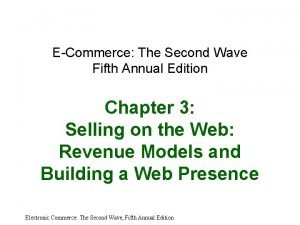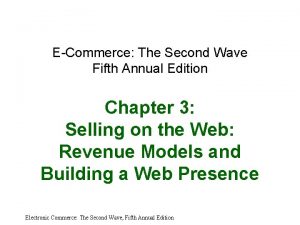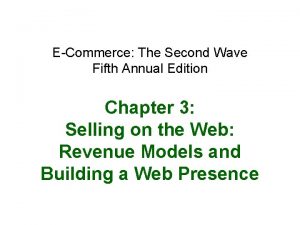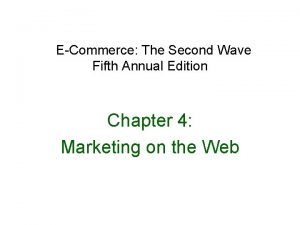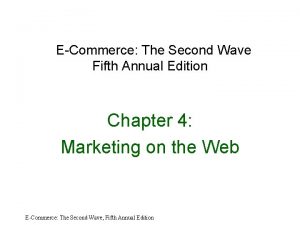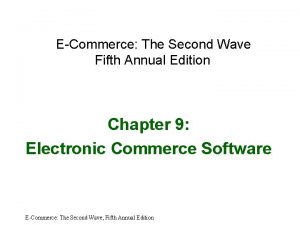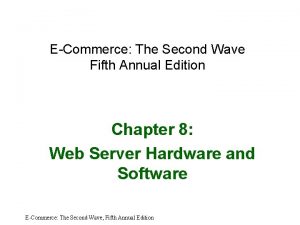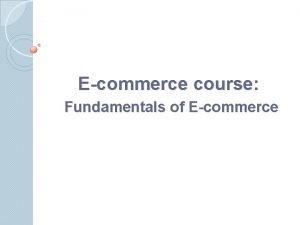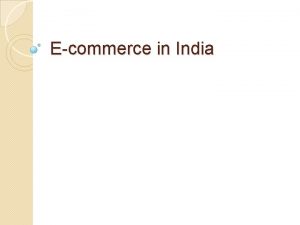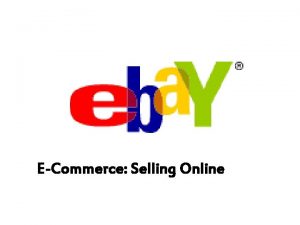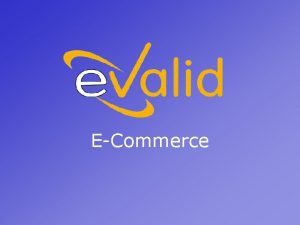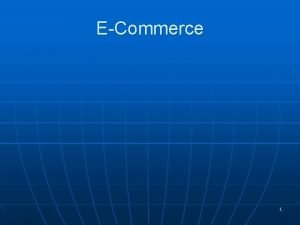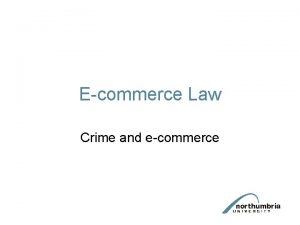ECommerce The Second Wave Fifth Annual Edition Chapter

























































- Slides: 57

E-Commerce: The Second Wave Fifth Annual Edition Chapter 1: Introduction to E-commerce/e -Business E-Commerce: The Second Wave, Fifth Annual Edition

About me! • • • Nehemiah Mavetera Lecturer at SIT(ZA) BSc Survey(Hons) UZ PM Geoinformation Management(ITC) Netherlands Ph. D in IT(UP) -current 8 yrs. Experience in Land, Engineering & Mining Surveying, Project Manager. Lecturer in Photogrammetry, Surveying, Land Information Management at Harare Polytechnic(ZW) Lecturer in IT, Monash University SA Campus, Senior lecturer INF-NWU Research Interests: E-Business/ E-markets, Ontologies, Software agents & E-Governance. E-Commerce: The Second Wave, Fifth Annual Edition 2

Assessment • Coursework and Examination • Coursework=50% • Coursework= tests(2), project, and labs in Html, xml and Front. Page. • 40% of coursework=Tests and quizzes • 60% of coursework=Project • Exam=50% • You need C+FE=>50/100 to pass. E-Commerce: The Second Wave, Fifth Annual Edition 3

Resources • Textbook: Gary Schneider, Electronic Commerce: The Second Wave, Fifth Edition, Course Technology Incorporated, 2004, 0 -619 -21331 -0 • Study: Lecture notes • Lab Sessions: DP lab, www. w 3 schools. com-html, xml and others. • Assignments E-Commerce: The Second Wave, Fifth Annual Edition 4

Contact Details • • • Office GAB 221 Tel: 018 389 2143 Email: Maveteran@uniwest. ac. za Office Hours: 9 am-3 pm Subjects Taught: INF 113, INF 215, INF 711, INF 799. • Duties: Honors Program Coordinator & Students Advisor E-Commerce: The Second Wave, Fifth Annual Edition 5

OUTCOMES • In this chapter, students must know: • What electronic commerce is and how it is poised for a second wave of growth and profitability • Why business models have given way to revenue models and the analysis of business processes as key elements of electronic commerce initiatives E-Commerce: The Second Wave, Fifth Annual Edition 6

OUTCOMES • How economic forces have created a business environment that is fostering a rebirth of electronic commerce How businesses use value chains to identify electronic commerce opportunities • How businesses use SWOT analysis to analyze and evaluate business opportunities E-Commerce: The Second Wave, Fifth Annual Edition 7

OUTCOMES • Why electronic commerce is international by its very nature and what challenges arise in doing global electronic commerce E-Commerce: The Second Wave, Fifth Annual Edition 8

Trading at a Distance Purchase Order PO Acknowledgment Delivery Docket PRODUCT Vendor’s Customer’s System Signed Delivery Docket System Invoice Remittance Advice CASH Statement E-Commerce: The Second Wave, Fifth Annual Edition Information exchanges in trading 9

Product & Cash Control System CUSTOMER VENDOR Sales Orders and Dispatching Debtors Control PRODUCT Purchase Orders and Receiving CASH E-Commerce: The Second Wave, Fifth Annual Edition Creditors Control 10

B 2 B E-Commerce VENDOR CUSTOMER EDI Vendor Schedule / P. O. Enter Shipment Details Sales EDI P. O. Ackn. Purchase Ordering Dispatch Bar coded Product Info Requirements Scan Bar coded Products EDI A. S. N. PRODUCT Requirements Enter Receiving Receipt Advice Print Bar code Labels Accounts Receivable EDI Invoice Accounts Payable Cash and Remittance Advice Via EFT Customer Bank Vendor Bank This is where we are heading E-Commerce: The Second Wave, Fifth Annual Edition A. C. H 11

Electronic Commerce: The Second Wave • Electronic commerce (e-commerce) – Businesses trading with other businesses and internal processes • Electronic business (e-business) – Term used interchangeably with e-business – The transformation of key business processes through the use of Internet technologies E-Commerce: The Second Wave, Fifth Annual Edition 12

Categories of Electronic Business • Five general e-business categories – Business-to-consumer – Business-to-business – Business processes – Consumer-to-consumer – Business-to-government • Supply management or procurement – Departments devoted to negotiating purchase transactions with suppliers E-Commerce: The Second Wave, Fifth Annual Edition 13

What is e-business? • “The seamless application of information and communication technology from its point of origin to its end point along the entire value chain of business processes conducted electronically and designed to enable the accomplishment of a business goal” • Too complex? E-Commerce: The Second Wave, Fifth Annual Edition 14

What is e-business? • “The buying and selling of goods and services on the Internet, especially the WWW. ” • “Electronic techniques for accomplishing business transactions, inclusing electronic mail or messaging, WWW technology, electronic bulletin boards, purchase cards, electronic funds transfers, and electronic data interchange. ” • Too narrow? E-Commerce: The Second Wave, Fifth Annual Edition 15

What is e-business? • These are better: “The strategic deployment of computer-mediated business tools and information technologies to satisfy business objectives. ” “Sharing business information, maintaining business relationships, and conducting business transactions by means of telecommunications networks. ” E-Commerce: The Second Wave, Fifth Annual Edition 16

What can we do on the Internet, these days? • • Paying bills Online games and gambling Searching for information Creating virtual communities Communication email, web cam, etc. Dating! Buying and selling goods, services and stocks Getting a degree distance learning, virtual campus, virtual universities!, virtual tours E-Commerce: The Second Wave, Fifth Annual Edition 17

Types of e-business • Business to Consumer (B-to-C) • Business to Business (B-to-B) • Intraorganisational e-business • Consumer to Consumer (C-to-C) • Business/Consumer to Government E-Commerce: The Second Wave, Fifth Annual Edition 18

Types of e-business • Relationships in EC Aggregation Suppliers Matching Consumers Facilitation E-Commerce: The Second Wave, Fifth Annual Edition 19

What makes e-business work? • Business • Technologies • People E-Commerce: The Second Wave, Fifth Annual Edition 20

Elements of Electronic Commerce E-Commerce: The Second Wave, Fifth Annual Edition 21

Categories of Electronic Commerce (Continued) • Transaction – An exchange of value • Business processes – The group of logical, related, and sequential activities and transactions in which businesses engage • Telecommuting or telework – Employee logs in to company computer through Internet instead of traveling to office E-Commerce: The Second Wave, Fifth Annual Edition 22

Electronic Commerce Categories E-Commerce: The Second Wave, Fifth Annual Edition 23

The Development and Growth of Electronic Commerce • Electronic funds transfers (EFTs) – Also called wire transfers – Electronic transmissions of account exchange information over private communications networks • Electronic data interchange (EDI) – Transmitting computer-readable data in a standard format to another business E-Commerce: The Second Wave, Fifth Annual Edition 24

The Development and Growth of Electronic Commerce (Continued) • Trading partners – Businesses that engage in EDI with each other • Value-added network (VAN) – Independent firm – Offers connection and transaction-forwarding services to buyers and sellers engaged in EDI E-Commerce: The Second Wave, Fifth Annual Edition 25

Actual and Estimated Online Sales in B 2 C and B 2 B Categories E-Commerce: The Second Wave, Fifth Annual Edition 26

The Second Wave of Electronic Commerce • Defining characteristics of first wave – Dominant influence of U. S. businesses – Extensive use of the English language – Low bandwidth data transmission technologies – Unstructured use of e-mail – Overreliance on advertising as a revenue source E-Commerce: The Second Wave, Fifth Annual Edition 27

The Second Wave of Electronic Commerce (Continued) • As second wave begins – Future of electronic commerce will be international in scope – Language translation and handling currency conversion problem will need to be solved – E-mail will be used as an integral part of marketing and customer contact strategies E-Commerce: The Second Wave, Fifth Annual Edition 28

Business Models, Revenue Models, and Business Processes • Business model – A set of processes that combine to yield a profit • Revenue model – Used to • Identify customers • Market to those customers • Generate sales to those customers E-Commerce: The Second Wave, Fifth Annual Edition 29

Focus on Specific Business Processes • Merchandising – Combination of store design, layout, and product display knowledge • Commodity item – Hard to distinguish from the same products or services provided by other sellers – Features have become standardized and well known E-Commerce: The Second Wave, Fifth Annual Edition 30

Focus on Specific Business Processes (Continued) • Shipping profile – Collection of attributes that affect how easily a product can be packaged and delivered • High value-to-weight ratio – Can make overall shipping cost a small fraction of the selling price E-Commerce: The Second Wave, Fifth Annual Edition 31

Advantages of Electronic Commerce • Can increase sales and decrease costs • If advertising done well on the Web – Can get a firm’s promotional message out to potential customers in every country • Using e-business sales support and ordertaking processes, a business can – Reduce costs of handling sales inquiries – Provide price quotes E-Commerce: The Second Wave, Fifth Annual Edition 32

Advantages of Electronic Commerce (Continued) • Increases purchasing opportunities for buyer • Negotiating price and delivery terms is easier • The following cost less to issue and arrive securely and quickly – Electronic payments of tax refunds – Public retirement – Welfare support E-Commerce: The Second Wave, Fifth Annual Edition 33

Disadvantages of Electronic Commerce • Perishable grocery products are much harder to sell online • Difficult to – Calculate return-on-investment – Integrate existing databases and transactionprocessing software into software that enables e-business • Cultural and legal obstacles also exist E-Commerce: The Second Wave, Fifth Annual Edition 34

Economic Forces and Electronic Commerce • Economics – Study of how people allocate scarce resources • Two conditions of a market – Potential sellers of a good come into contact with potential buyers – A medium of exchange is available E-Commerce: The Second Wave, Fifth Annual Edition 35

Transaction Costs • Total costs that a buyer and seller incur • Significant components of transaction costs – Cost of information search and acquisition – Investment of seller in equipment or in the hiring of skilled employees to supply product or service to buyer E-Commerce: The Second Wave, Fifth Annual Edition 36

The Role of Electronic Commerce • Businesses and individuals – Can use electronic commerce to reduce transaction costs by • Improving flow of information • Increasing coordination of actions E-Commerce: The Second Wave, Fifth Annual Edition 37

Network Economic Structures • Network economic structure – Companies coordinate their strategies, resources, and skill sets • Strategic alliances (strategic partnerships) – Relationships created within the network economic structure E-Commerce: The Second Wave, Fifth Annual Edition 38

Network Economic Structures (Continued) • Virtual companies – Strategic alliances that occur between or among companies operating on the Internet • Strategic partners – Come together as a team for a specific project or activity E-Commerce: The Second Wave, Fifth Annual Edition 39

Network Effects • Law of diminishing returns – Most activities yield less value as the amount of consumption increases • Network effect – As more people or organizations participate in a network • Value of network to each participant increases E-Commerce: The Second Wave, Fifth Annual Edition 40

Value Chains in Electronic Commerce • Strategic business unit – One particular combination of product, distribution channel, and customer type • Firm – Multiple business units owned by a common set of shareholders • Industry – Multiple firms that sell similar products to similar customers E-Commerce: The Second Wave, Fifth Annual Edition 41

Strategic Business Unit Value Chains • Value chain – A way of organizing the activities that each strategic business unit undertakes • Primary activities – Design, produce, promote, market, deliver, and support the products or services it sells • Supporting activities – Human resource management and purchasing E-Commerce: The Second Wave, Fifth Annual Edition 42

Value Chain for a Strategic Business Unit E-Commerce: The Second Wave, Fifth Annual Edition 43

Industry Value Chains • Value system – Larger stream of activities into which a particular business unit’s value chain is embedded – Also referred to as industry value chain E-Commerce: The Second Wave, Fifth Annual Edition 44

Industry Value Chain for a Wooden Chair E-Commerce: The Second Wave, Fifth Annual Edition 45

SWOT Analysis: Evaluating Business Unit Opportunities • SWOT analysis – Analyst first looks into the business unit to identify its strengths and weaknesses – Analyst then reviews operating environment and identifies opportunities and threats E-Commerce: The Second Wave, Fifth Annual Edition 46

SWOT Analysis Questions E-Commerce: The Second Wave, Fifth Annual Edition 47

Results of Dell’s SWOT Analysis E-Commerce: The Second Wave, Fifth Annual Edition 48

International Nature of Electronic Commerce • Companies with established reputations – Often create trust by ensuring that customers know who they are – Can rely on their established brand names to create trust on the Web • Customers’ inherent lack of trust in “strangers” on the Web – Logical and to be expected E-Commerce: The Second Wave, Fifth Annual Edition 49

This Cartoon from The New Yorker Illustrates Anonymity on the Web E-Commerce: The Second Wave, Fifth Annual Edition 50

Language Issues • To do business effectively in other cultures – Must adapt to culture • Researchers have found that – Customers are more likely to buy products and services from Web sites in their own language • Localization – Translation that considers multiple elements of local environment E-Commerce: The Second Wave, Fifth Annual Edition 51

Culture Issues • Important element of business trust – Anticipate how the other party to a transaction will act in specific circumstances • Culture – Combination of language and customs – Varies across national boundaries – Varies across regions within nations E-Commerce: The Second Wave, Fifth Annual Edition 52

Infrastructure Issues • Internet infrastructure includes – Computers and software connected to Internet – Communications networks over which message packets travel • Organization for Economic Cooperation and Development’s (OECD) – Statements on Information and Communications Policy • Deal with telecommunications infrastructure development issues E-Commerce: The Second Wave, Fifth Annual Edition 53

Infrastructure Issues (Continued) • Flat-rate access system – Consumer or business pays one monthly fee for unlimited telephone line usage – Contributed to rapid rise of U. S. electronic commerce • Targets for technological solutions – Paperwork and processes that accompany international transactions E-Commerce: The Second Wave, Fifth Annual Edition 54

Parties Involved in a Typical International Trade Transaction E-Commerce: The Second Wave, Fifth Annual Edition 55

Summary • Commerce – Negotiated exchange of goods or services • Electronic commerce – Application of new technologies to conduct business more effectively • First wave of electronic commerce – Ended in 2000 • Second wave of electronic commerce – New approaches to integrating Internet technologies into business processes E-Commerce: The Second Wave, Fifth Annual Edition 56

Summary • Using electronic commerce, businesses have – Created new products and services – Improved promotion, marketing, and delivery of existing offerings • Global nature of electronic commerce – Leads to many opportunities and few challenges • To conduct electronic commerce across international borders – You must understand the trust, cultural, and language legal issues E-Commerce: The Second Wave, Fifth Annual Edition 57
 One two three first second third
One two three first second third Integrate nic
Integrate nic Principles of marketing fifth european edition
Principles of marketing fifth european edition Psychology ciccarelli 5th edition chapter 1
Psychology ciccarelli 5th edition chapter 1 Fundamentals of corporate finance fifth edition
Fundamentals of corporate finance fifth edition Fifth edition chemistry a molecular approach
Fifth edition chemistry a molecular approach Molecular biology
Molecular biology Molecular biology of the cell fifth edition
Molecular biology of the cell fifth edition Human anatomy fifth edition
Human anatomy fifth edition Human anatomy fifth edition
Human anatomy fifth edition 186 282 miles per second into meters per second
186 282 miles per second into meters per second Advanced word power second edition answers
Advanced word power second edition answers Accounting principles second canadian edition
Accounting principles second canadian edition Accounting principles second canadian edition
Accounting principles second canadian edition Accounting principles second canadian edition
Accounting principles second canadian edition Clear thinking and writing second edition answer key
Clear thinking and writing second edition answer key Accounting principles second canadian edition
Accounting principles second canadian edition Kaufman tamine
Kaufman tamine Introduction to algorithms second edition
Introduction to algorithms second edition In company second edition
In company second edition Wechsler individual achievement test second edition
Wechsler individual achievement test second edition Ten steps to advanced reading answer key
Ten steps to advanced reading answer key Organic chemistry
Organic chemistry Using mis (10th edition) 10th edition
Using mis (10th edition) 10th edition Using mis (10th edition) 10th edition
Using mis (10th edition) 10th edition First wave of colonialism
First wave of colonialism First wave civilizations
First wave civilizations Second wave of positive psychology
Second wave of positive psychology Senge fifth discipline summary
Senge fifth discipline summary Fifth chapter menu
Fifth chapter menu Light is electromagnetic wave true or false
Light is electromagnetic wave true or false Carbon dioxide temperature
Carbon dioxide temperature Difference between full wave and half wave rectifier
Difference between full wave and half wave rectifier Difference between transverse wave and longitudinal wave
Difference between transverse wave and longitudinal wave Half wave full wave rectifier
Half wave full wave rectifier Full wave rectification circuit
Full wave rectification circuit P and s wave chart
P and s wave chart Full wave rectified sine wave fourier series
Full wave rectified sine wave fourier series Wave wave repeating
Wave wave repeating The wave chapter 10
The wave chapter 10 Quarter-wave symmetry
Quarter-wave symmetry Mechanical wave and electromagnetic wave
Mechanical wave and electromagnetic wave Examples of mechanical waves
Examples of mechanical waves Transverse wave and longitudinal wave example
Transverse wave and longitudinal wave example Hình ảnh bộ gõ cơ thể búng tay
Hình ảnh bộ gõ cơ thể búng tay Frameset trong html5
Frameset trong html5 Bổ thể
Bổ thể Tỉ lệ cơ thể trẻ em
Tỉ lệ cơ thể trẻ em Chó sói
Chó sói Glasgow thang điểm
Glasgow thang điểm Hát lên người ơi alleluia
Hát lên người ơi alleluia Các môn thể thao bắt đầu bằng tiếng bóng
Các môn thể thao bắt đầu bằng tiếng bóng Thế nào là hệ số cao nhất
Thế nào là hệ số cao nhất Các châu lục và đại dương trên thế giới
Các châu lục và đại dương trên thế giới Công thức tiính động năng
Công thức tiính động năng Trời xanh đây là của chúng ta thể thơ
Trời xanh đây là của chúng ta thể thơ Cách giải mật thư tọa độ
Cách giải mật thư tọa độ 101012 bằng
101012 bằng


















